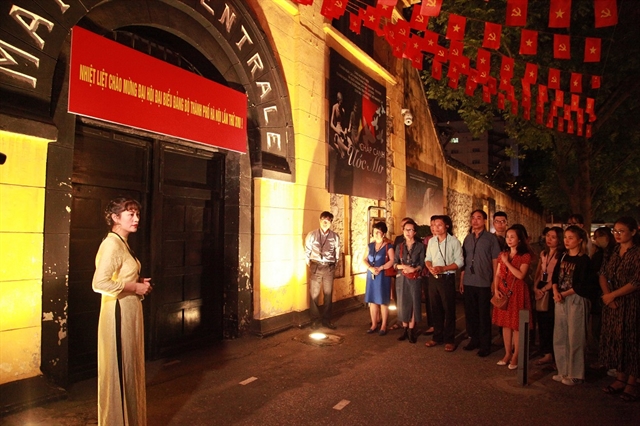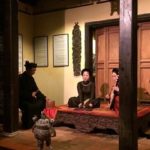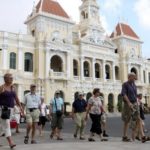As one relaxes in a bar, on the sidewalk, or nestled in a hidden corner of Hanoi, the bustling world passing by serves as a catalyst for the creation of vibrant works of art, music, and literature.
Hanoi has recently experienced a significant transformation following years of administrative boundary adjustments. Nguyen Truong Quy, a writer with a deep personal connection to the city, commented on the immense changes that have taken place. Hanoi, as we remember it, has expanded to such an extent that it astonishes individuals who have been away for an extended period of time.
The Hoan Kiem District is aptly named after its most iconic landmark, Hoan Kiem Lake, which holds great historical significance as the main symbol of Thang Long, the ancient capital of Vietnam. This district encompasses the entirety of the former Tho Xuong district, showcasing a rich heritage from the successive Dai Viet dynasties.
The Hoan Kiem District was previously known as the Hoan Kiem Zone from 1961 to 1981.
| Tourists join the night tour at Hoa Lo Prison Relic. Photo: Hoalo.vn |
In January 1981, the area previously known as Hoan Kiem Zone was officially designated as Hoan Kiem District, comprising of 18 wards. This title has been maintained ever since.
Hoàn Kiếm District boasts a multitude of prominent government agencies, embassies, and international organizations as its residents. Renowned for its exceptional services, expansive commercial streets, and bustling wholesale markets, this district truly stands out in terms of business and commerce.
Hanoi, the capital city of Vietnam, holds great significance in terms of its cultural, political, and economic influence. Boasting a rich history spanning a millennium, Hanoi is home to a remarkable collection of 190 historical and cultural relics. Among its notable landmarks are the prestigious Sword Lake, the iconic Huc Bridge, the majestic Hanoi Opera House, the renowned Long Bien Bridge, and the revered King Le Temple. These remarkable works stand as a testament to the enduring legacy of Hanoi’s civilization.
The Ancient Thang Long, also known as the “36 streets,” is located in the Old Quarter in Hoan Kiem District. This historic area is characterized by its numerous streets, each of which is named with the prefix “Hang” (meaning guild).
| Thap Rua (Turtle Tower) is one of the landmarks of Hanoi. Photo: VNA |
Hoan Kiem District is known for its historic “hang” streets, which were once gathering places for talented individuals from all over the country. These streets still bear the names of their respective trades, such as Hang Dao (specializing in cloth dyeing and sales), Hang Trong (renowned for traditional crafts like folk painting and drum making), Hang Bac (the street of silversmiths), and Hang Da (the street of leather workers).
The renowned “Hanoi’s Old Quarter” is officially recognized as a significant national historical and cultural relic, adding immense value to Hanoi’s rich cultural heritage. This charming district has effectively preserved the traditional identity and allure of the sophisticated Hanoi populace.
The Vice Chairman of the Vietnam Association of Administrative Sciences, Dr. Pham Quang Long, highlights the significance of the Hoan Kiem Lake in relation to the story of King Le Thai To. It is said that the King successfully defended the country against foreign invaders with the help of a magical sword provided by the Genie Turtle. After achieving independence, the King dutifully returned the sword to the Golden Turtle.
The mere mention of each street name evokes a sense of nostalgia for those who have departed from the charming city of Hanoi. As noted by Pham Quang Long, the landmarks that define Hanoi, including the renowned Hoan Kiem, serve as a source of inspiration for various forms of creative expression, such as poetry, literature, music, and art.
According to former Deputy Minister of Interior, Thang Van Phuc, Hoan Kiem District holds great cultural, historical, and architectural importance, which positions it as the heart of Hanoi.
Must-See Destinations
The stunning Hoan Kiem Lake is a must-visit destination. With its mesmerizing beauty, this legendary lake captured the hearts of countless visitors. Located in the heart of Hanoi, the capital city of Vietnam, this picturesque lake is surrounded by historical sites and cultural landmarks, making it a popular spot for both locals and tourists.
The lake holds significant historical importance as a symbolic landmark in Hanoi. It is the first destination for visitors to the city and represents the identity of the Hoan Kiem District, referred to as Bo Ho or Ho Hoan Kiem or Ho Guom. During weekends, the area transforms into a pedestrian-only zone, hosting a variety of distinctive cultural events.
| Nam Huong Communal House in Hoan Kiem District is a favorite cultural rendezvous for locals and tourists. |
St. Joseph’s Cathedral, a Catholic church constructed in 1884 and officially opened on Christmas of 1887, stands as a significant landmark in Hanoi. Serving as a prominent testament to the city’s architectural evolution over the past two centuries, this Western-inspired structure holds historical value as one of the earliest buildings of its kind in the region. Today, St. Joseph’s Cathedral remains a popular gathering place for both locals and visitors, particularly the younger generation. Adjacent to the cathedral, one can enjoy an array of culinary delights, including coffee, iced tea, grilled pork roll, and chicken porridge as they soak in the vibrant atmosphere.
Hanoi Heritage Center is a prominent destination that showcases the exquisite beauty of the city’s ancient architecture, historic temples, and invaluable cultural heritage dating back thousands of years. This enchanting place not only captures the essence of Hanoi’s rich cultural heritage but also offers a tantalizing array of culinary delights. A visit to Hanoi is incomplete without exploring the wonders of Hanoi Heritage Center.
Dong Xuan Market
Dong Xuan Market, established in 1889, holds the distinction of being the biggest indoor market in Hanoi. This historic market boasts an extensive selection of goods, including fresh produce, souvenirs, accessories, clothing, electronics, and household items.
The venue also showcases the daily essence of life in historic Hanoi. Despite renovations, the market’s exterior has remained intact, offering a captivating glimpse into the city’s rich past and vibrant present. Additionally, on weekend evenings, the market transforms into a lively night bazaar, inviting pedestrians to explore and indulge in its lively atmosphere. Publicizing memorable moments in the heart of Hanoi.
Trang Tien Street
Trang Tien Street, which leads to Sword Lake, is a historically significant shopping district in Hanoi. During the French era, it gained a reputation for being a high-end destination for shoppers. Trang Tien Plaza, an iconic shopping mall, boasts remarkable colonial architecture and is a testament to the city’s rich history.
Don’t miss the opportunity to indulge in the delectable Trang Tien ice cream during your visit. This beloved treat has been captivating both Hanoi locals and tourists since its inception in 1958. Its enduring popularity can be attributed to the nostalgia it evokes, making it a must-try for anyone wanting to experience a taste of the past. Renowned as “the best in Vietnam,” Trang Tien Mung Bean Ice Cream is sure to leave a lasting impression.
Hoa Lo Prison Relic
Hoa Lo Prison holds great significance as a historical relic in Hanoi. Constructed in 1896 by the French colonists, the prison served as a means to incarcerate Vietnamese patriots. Known as Maison Centrale, it stood as one of the largest penitentiary centers during French colonialism in Indochina.
Over time, the prison underwent changes, and in 1993, the government made the decision to demolish Hoa Lo Prison, with the exception of a portion in the southeast. This remaining section was transformed into a historical relic, serving as a testament to the Vietnamese patriotic and revolutionary fighters.
To offer visitors a comprehensive understanding of the city’s history, a captivating night tour is available, allowing individuals to experience the significance of Hoa Lo Prison firsthand.
Ancient house in Ma May
NDO – Ma May, a rare quarter that still retains several old houses, has created one of the characteristics of Hanoi. Hanoi’s streets are becoming increasingly crowded and traditional features can sometimes be hidden behind modern life. But if one takes the time to relax and look around, the ancient features begin to reveal themselves.
Book festival “Hanoi – City for Peace” opens
NDO – The Hanoi book festival with the theme “Hanoi – City for Peace” opened at the Imperial Citadel of Thang Long in Hanoi on October 2, as part of activities to celebrate the 65th anniversary of the capital’s Liberation Day (October 10, 1954-2019).









